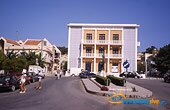 |
 |
 |
Arrivals – Departures |
|
 |
Athens International Airport – Eleftherios Venizelos |
|
|
 |
 |
 |
|
 |
 |
 |
Better check the weather... |
|
 National Observatory of Athens National Observatory of Athens |
 Poseidon Poseidon |
 Ntua.gr Ntua.gr |
 Accuweather Accuweather |
 Weather Underground Weather Underground |
|
|
 |
 |
 |
|
|
|
 |
 |
| Argostoli (Capital) |
  |
|
|
|
 It has about 7500 inhabitants and it is the capital of the city, as well as the third biggest port in the island.
After the 1953 earthquake the city was built anew, preserving the exact same style it had before. It stands in the middle of a naturally formed bay thanks to the Venetians that moved it to its present location in 1757. The destructive 18th century earthquakes tore down the castle of Agios Georgios (Saint George), which used to be the island’s capital during the Venetian domination. The 1 km long bridge that connects Argostoli to the other side of the bay was designed by the English, separating the port from the lagoon of Kouvatos. |
| |
| Worth seeing |
•The Korgialenios Library and the Archaeological Museum (tel. 28300), where you can admire finds from different excavations covering various periods.
•The remains of ancient Krani, east of the city (3 km)
•Katavothres, 2,5 km away from the city. The cracks on the ground practically swallow the sea and it is estimated that there’s 150.000 sq m of water going down these cracks every day.
•The village of Markopoulos, famous for the black snakes with the cross-like shape on their heads that appear in the middle of August. The locals call them «fidakia tis Panagias», which means snakes of the Virgin.
•The lighthouse of Agioi Theodoroi, built by the English in 1820.
•The beach of Mirtos. It’s one of the most famous beaches in all of Kefalonia, located near the village of Divaratsa. |
| |
| Where to swim |
| At Plati and Makri Gialo. You can also try Kamaroula, Gradakia and Agia Pelagia. |
|
|
|
|
|
 |
 |
|
|
|
 |
 |
 |
|
|
|
 |
 |
|
|


